#the book example is not longer in print
Explore tagged Tumblr posts
Text
👑Tips for littles on a budget👑
This is some tips for tinies (or carers looking for gifts for kiddos) on a budget! Of course you don't need any gear to be a good regressor but a lot of us like toys etc. and it's okay to want them!
🧸thrift stores, a lot of thrift stores have toys and plushies, sometimes they are a bit broken or dirty but there are lots of tutorials on YouTube for cleaning and restoring plushies and toys🧸
🐾e-books, you can find kids books online as e-books which are often pretty cheap or you can watch tiktoks of people reading those books🐾
🩷diy onesies, a lot of regressors like onesies but the prices are pretty steep, if you can't afford them don't fret! Its super easy and affordable to make one yourself all you need is an old t-shirt and snap buttons plus a way to attach them, just get a big t-shirt, sweatshirt or even hoodie and add 2-4 snap buttons in the crotch, boom you have a super cute and discreet onesie!🩷
🧸diy toys, there are lots of toys you can make yourself either by sewing or crafting and there's lot soft videos on YouTube for it, or get creative🧸
🐾mobile games, I love to play video games when im regressed but game consoles are expensive so free mobile games are a great alternative🐾
🩷dollar store etc, while you shouldn't rely on stores or websites that use cheap labor for everything it's okay to make exceptions every now and then, especially for toys, pacis, sippy cups and similar🩷
🧸pull ups, instead of cute printed diapers get big kid pull-ups in the baby-section or medical diapers from a drugstore, they are less then half the price of a pack of adult diapers from brands like tears etc.🧸
🐾learn to diy, making things yourself is often the most affordable thing to do, not with everything obviously but with a lot of things, learn as much stuff as you can so you can make lots of gear yourself🐾
🩷look for affordable stores, lots of paci stores on Instagram are very affordable and the ones that aren't often have sales so keep an eye out for that, lots of shops also have promoter codes they are happy for you to use, for example with my code 'bunnybab' you get a small discount at pacisbybunnie and cozypacicorner🩷
🧸buy second hand, thrift stores are a great place but if you want little specific stuff looking on vinted, swoop or even insta is a great idea! Lots of people sell gear they no longer connect with🧸
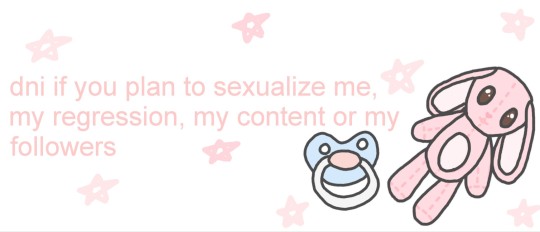
Fun fact of the day: Bluey's pilot was only a minute long and never actually aired
#agere post#boyre#noncom agere#safe agere#sfw agere#boy regressor#boy regression#agere blog#age regressor#ageregression#agere tips#caregiver tips#agere resources#noncom regressor#noncom regression#non community little#sfw little boy#sfw littlespace#agere cg#cg advice#innerchildhealing#age regression#sfw agereg#agere carer#toddler regressor#baby regressor#noncom#sfw little post#sfw little community#agere
904 notes
·
View notes
Note
what to do if there's too much dialogue in my story? how do i fix the 'not enough action'?
also what if my story's too short? it's supposed to be a novel
How Long Should a Novel Be? If you’re writing your first novel, the general rule of thumb for novel writing is a word count in the 80,000 to 100,000 range.
While anything over 40,000 words can fall into the novel category, 50,000 is considered the minimum novel length.
Anything over 110,000 words is considered too long for a fiction novel.
Each book in J.R.R. Tolkien’s The Lord of the Rings trilogy has an enormous word count, with the longest clocking in at over 175,000 words.
Despite their ongoing success, those epic sagas are the rare exception to general word count rules.
Typically, you’ll want your novel to be much shorter.
Within the world of literary fiction, different genres follow more specific word count targets:
Thriller: A good suspense story has to keep the plot moving to keep the reader engaged. The ideal count for a mystery is a 70,000 and 90,000 word novel.
Science fiction and fantasy: Sci-fi novels are an art in world-building. The need to invent a completely new environment makes this genre longer than others. A fantasy novel will usually have 90,000 to 120,000 words.
Romance novels: Not every love story is an epic like Wuthering Heights. Romantic plots now tend to be fun, fast reads. Some are as short as 50,000 words—the perfect book for a beach vacation. The high-end romance novel word count is 100,000.
Historical fiction: Fleshing out an imagined historical world lends itself to a higher word count, so historical fiction tends to be closer to 100,000 words.
Non-fiction: There is no definitive word count guide for non-fiction books due to the many subgenres. If you’re writing a non-fiction book, be sure to look up that category to find the length of similar books. For example, memoirs are generally 80,000 to 90,00 words.
Reasons Word Count Is Important in Writing. While there are no hard and fast rules on the amount of words a book needs, there are highly-suggested guidelines in the traditional publishing industry, especially for first time authors.
Unless you’re self-publishing, you’ll need to pay attention to how many words you use to compose your first draft. Here are 3 reasons why word count is important:
Shorter novels are more marketable. A literary agent and traditional publisher are less likely to take a chance on long novels when they come from a new writer. An adult fiction book is most marketable in the suggested word count.
Longer novels are more expensive to print. Longer books increase the number of pages that need to be printed. That makes them more expensive to print and a bigger investment.
Audiences expect a certain word count. Audiences are used to a certain story length and page count, so an unknown author can attract more readers by staying in the expected range.
Too Much Dialogue. Some stories rely heavily on dialogue. Others have very little. Most strike a balance somewhere in between.
To determine what's right for your own story, consider the effect so much dialogue has on the reader's experience.
What atmosphere does it create?
How does it impact the reader's understanding of the characters or the situation?
Keep in mind the role of dialogue and its limitations.
Some dialogue-heavy fictions fail because the dialogue is used carelessly.
Make sure you're not cramming information into dialogue when it might be more appropriate in narrative.
Also, be thoughtful when considering what to include in an exchange.
Crafting a scene is all about selectivity and you should include only what's important.
Example: Post-work chitchat might be commonplace in real life, but it's not terribly exciting in fiction. If the heart of the scene is to reveal a character's insecurities about the drive, we don't need fluff taking up space.
Since there's no set formula for how much dialogue you can use, keep an eye out for these common pitfalls and consider the effect of a dialogue-heavy read in the context of your work.
This should help you figure out if you've used too much or just the right amount.
Is it possible to use too much dialogue?
Here's one answer: No, a story can't have too much dialogue. Plenty of stories, including many by Ernest Hemingway and Raymond Carver, rely heavily on dialogue.
Of course, the opposite answer is true, too: Yes, it's possible to use too much dialogue. If the dialogue is unnecessary, it's “too much." That might happen in a story packed full of dialogue or one that has only a few lines of it. Exchanges should move the story forward and reveal something significant.
Relying on dialogue may be a stylistic choice, but an exchange shouldn't be an indiscriminate volley of words. It should have purpose.
More strategies for improving the dialogue in your own work:
Mix dialogue with narration. Long runs of dialogue can dislodge a reader from the action of a scene. As your characters talk, interpolate some descriptions of their physical postures or other activity taking place in the room. This mimics the real-world experience of listening to someone speaking while simultaneously taking in visual and olfactory stimuli.
Give your main character a secret. Sometimes a line of dialogue is most notable for what it withholds. Even if your audience doesn’t realize it, you can build dynamic three-dimensionality by having your character withhold a key bit of information from their speech. For instance, you may draft a scene in which a museum curator speaks to an artist about how she wants her work displayed—but what the curator isn’t saying out loud is that she’s in love with the artist. You can use that secret to embed layers of tension into the character’s spoken phrases.
Look to great examples of dialogue for inspiration. If you're looking for a dialogue example in the realm of novels or short stories, consider reading the great books written by Mark Twain, Judy Blume, or Toni Morrison. Within the world of screenwriting, Aaron Sorkin is renowned for his use of dialogue.
Tips for "not enough action"
Create visuals. Use action in a concise, impactful manner in order to deliver strong images for the audience. The clearer your scenes are, the more easily the audience can understand and absorb them. You don’t want readers or viewers to be hung up on seemingly impossible details or sequences that don’t flow. Visuals that get right to the point and can be quickly understood are best for conveying action.
Technical writing style. Whether you’re writing descriptive paragraphs in a novel or stage directions in a script or screenplay, you must be able to articulate the scene you envision in your head without wearing down your reader with technical drivel. Balancing specific details of your action sequences with a propulsive story isn’t easy to do. Sometimes a great action sequence doesn’t come together in a first draft, so focus your revisions on clarifying each action and providing vivid detail without besieging your reader with dull technical terms.
Striking a balance. There are no hard-and-fast rules about when and when not to blend dialogue, action, and narrative. To weave them together well is to find your story's rhythm. But there are a few questions you can ask yourself about your story, especially in the rewrite stage, that can help you know which elements are most effective for a particular scene, and which might be better used elsewhere.
Ask yourself:
Is the story moving a little too slowly, and do I need to speed things up? (Use dialogue.)
Is it time to give the reader some background on the characters so they're more sympathetic? (Use narrative, dialogue, or a combination of the two.)
Do I have too many dialogue scenes in a row? (Use action or narrative.)
Are my characters constantly confiding in others about things they should only be pondering in their minds? (Use narrative.)
Likewise, are my characters alone in their heads when my characters in conversation would be more effective and lively? (Use dialogue.)
Is my story top-heavy in any way at all—too much dialogue, too much narrative, or too much action? (Insert more of the elements that are missing.)
Are my characters providing too many background details as they're talking to each other? (Use narrative.)
Whether we're using dialogue, action, or narrative to move the story forward, any or all 3 of these elements are doing double duty by revealing our characters' motives.
Your story's dialogue can reveal motive in a way that's natural and authentic because whether we're aware of it or not, we reveal our own motives all the time in our everyday lives.
And to understand a character's motive is to understand the character.
Sources: 1 2 3 4 5 6 7 ⚜ More: References ⚜ Writing Resources PDFs
More Tips & References on Dialogue
On Narrative Pacing
Hope this helps with your writing!
#dialogue#novel#word count#writeblr#writing tips#writing reference#on writing#writing advice#writing inspiration#writing ideas#dark academia#writers on tumblr#literature#writing prompt#spilled ink#creative writing#writing resources
88 notes
·
View notes
Text



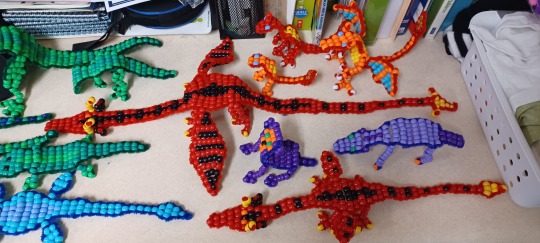
When I first took over as the lead teacher of the older school age room at my daycare, one of the activities I introduced into the room was making bead critters - a 90's kid tradition that has proved to have a timeless appeal, even if there's no longer books of patterns for this project to buy anymore. I mean, there's probably used ones, but I don't know any titles to look up on the usual sites so yeah they're more or less unavailable to me. Luckily, the internet has some patterns on it, and I printed out, like, 15 at the time and put them in my room. It's been a consistently popular hobby for the kids - sometimes they start up little production chains ad sell their creations to their classmates for the in-classroom currency we use, it's pretty rad.
Well, this summer they surprised me by finding and bringing in new patterns they found with their parents' help, and some of them had techniques I'd never seen before, which got my monster-maker brain working. So I went out, bought some pipe cleaners and beads of my own (both because I don't want to waste materials the center bought for my kids to use, and because the cheap pipe cleaners my work buys are made of aluminum and provoke a mild allergic reaction in me when I use them), and brought them in to do some experiments.
...and now we have some very big, very complex bead critterr to go with the initial batch of examples I made a couple years ago (as well as the lizards I used to decorate some of my cabinet doors). I'm especially proud of the big red and black dragon, it came out well. The downside is that the kids want to learn how to make it and, like, that was a frustrating three hour project for me, an adult with years of experience doing bullshit like this, I don't know if I want to inflict that on a kid.
But I could make it one of the new class prizes - "earn fifty varsity bucks and Mr. Will will make you a bead dragon, you get to choose the colors."
There's one new technique in the patterns they dug up that I only briefly experimented with today, but am proud I figured out how to do - it allows you to make protrusions in the middle of the critter, instead of just on the sides. Which means the one monster my kids suggested I make might be possible.
I could make a bead Godzilla.
Gonna need to buy more pipe cleaners, though.
137 notes
·
View notes
Text
Archive Classics: Typesetting Fics
TL; DR: the internet is temporary!!! printed books (for your own private amusement) are forever!!!
What I do:
Basically, I choose fics that I think deserve to be printed and typeset them using a software called Adobe InDesign. InDesign is the professional standard in the industry, but there are definitely easier (and cheaper!) options for formatting.
Once I've chosen a fic, there a few different things I have to decide: the font, glyphs, book size, and the hors-texte (title page, contents, etc).
Then, I go about copy + pasting the text into the software, and formatting them. Usually, that just means deleting the blank space of lines that for some reason appears between paragraphs.
Every element, and I mean every single element, is designed for the reader's comfort. At no point should the reader feel lost or unable to continue because of the way the text is formatted. This means using serif fonts instead of sans-serif fonts for the body text and making sure that there aren't any widows/orphan lines. I have specific justification settings so that the spacing between words and letters are even and smooth to the reader's eye.
I also think about headers and page numbers more than you would expect. Should the page numbers be on top or bottom? Centered or at the corners. Should I have headers at all? And if so, what should they say?
When I began, and I still do this occasionally, I grabbed books off my shelves and examined their formatting. Then I'd question why they made this design choice or that. All publishers have their special little quirks and features, and if I spotted something I liked, I would incorporate that into my own works. For example, Penguin Classics love their classic serif fonts and headers. Barnes and Noble Classics have a feature in their hors-texte that is their "From the Pages Of" section.
My favorite part is creating the cover. If you couldn't tell based off the title "Archive Classics," I *borrowed* Penguin Classic's grid. I love to use paintings or other kinds of artwork (like Étienne-Louis Boullée's architectural drawings for Fractals)
Why I Do This:
While there are many amazing and necessary reasons to read e-books, I enjoy the physicality of a printed book. Nothing can beat the sensation of turning the next page, the smell of paper, or the weight of your next great adventure in your hands. Fanfiction more than deserves to be experienced in that way too.
But also, I've always had a lingering suspicion regarding the temporal nature of digital media and of the internet in general. Fanfiction, in particular, are at risk of disappearing forever, and while you can obvs download it (which I always always do), there's a slight chance that you may not be able to access the technology in order to view it. Books don't require laptops or phones or internet service.
It's a silly movie, but Leave the World Behind (2023) showcases this perfectly, albeit with streaming services and dvds.
Finally, with the ever-changing landscape of the internet and technology, who knows if say archaeologists would be able to access ao3 in a 100 or even 50 years. Look at USB-As, and how quickly they're going out of use. Physical media like printed books will certainly last for decades longer. My ultimate (and idealistic) goal is to have a physical, printed library of fanfiction for both private enjoyment and for the academic study of fanfiction in the anthropological and literary fields. The latter will most likely not happen in my lifetime (if ever at all), but a girl can dream!
Copyright
This is slightly sketchy but from what I can tell from my research is that most sites don't give an af if you print like one copy for yourself and you do not print en-masse or start selling them. So like Manacled. Don't do what those kids did and put up your copies on etsy. I don't. I print this for myself and myself only. And I've never gotten a cease and desist letter or anything like that.
Requests are open: if you have a fic you think deserves the archive classics treatment, lmk! I do not accept payment. This is all free.
Examples!
A Current Cover I'm Working On:
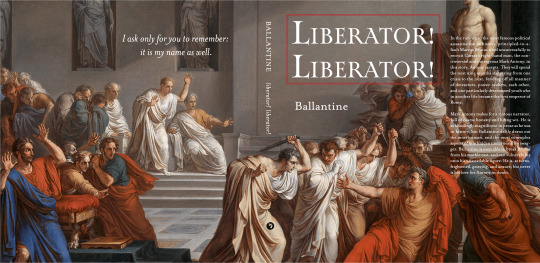
This one is a linen wrap, which means it has flaps!
#archive classics#typesetting#book design#indesign#fanfiction#ao3#the temporary nature of the internet is something we should be deeply concerned about!!#fanbinding
65 notes
·
View notes
Text

Hey Tumblr. I'm just a guy, not a company. I released a book (of comics) last weekend. I would like to tell you about it.
It's called 'Babyology'. It's mostly about my dog and baby:
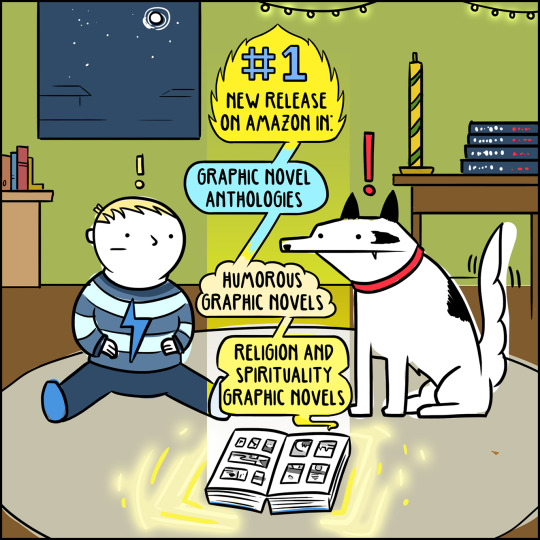
I'm there also, with my wife.
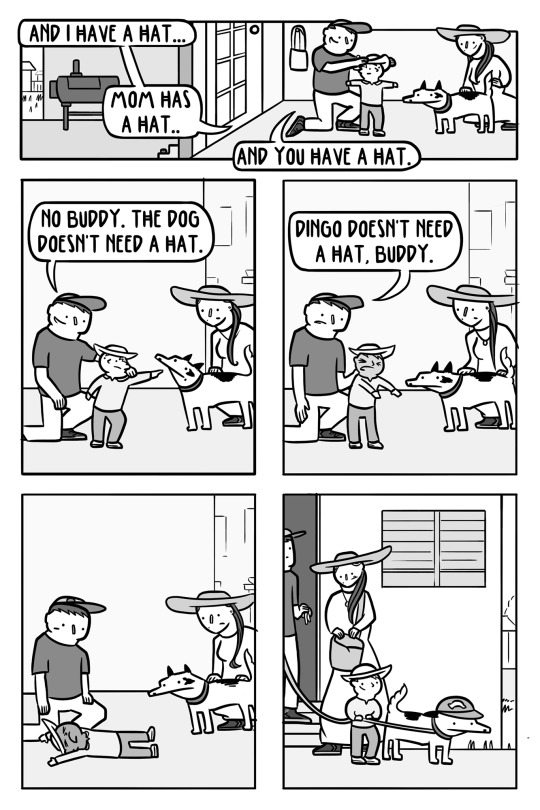
It's part anthology: the first two years of this series about us having a kid and starting a family, and all the weird stuff I'm into.
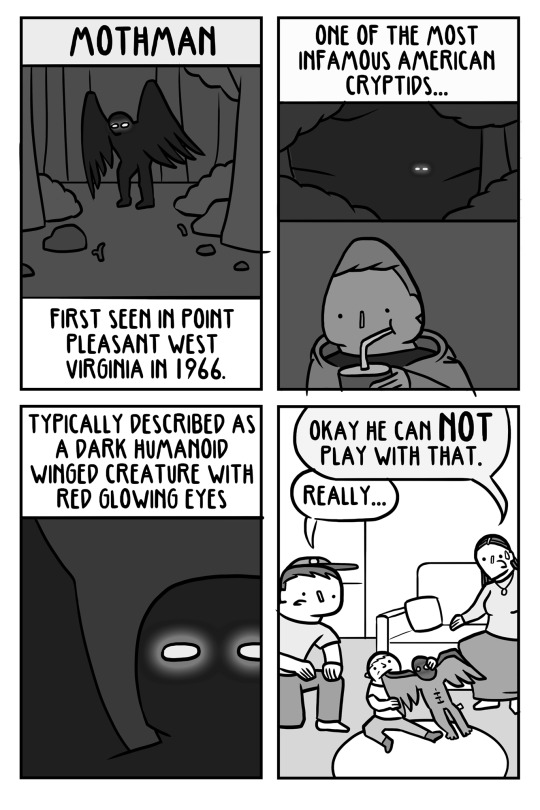
It's also longer comics I've kept behind the scenes until now.
The other main theme in the book is 'weird American religion'. Sometimes we go into atypical Christian history stuff, or just interesting ideas I come across - for example, what Mormon philosophy has to say about why evil exists:
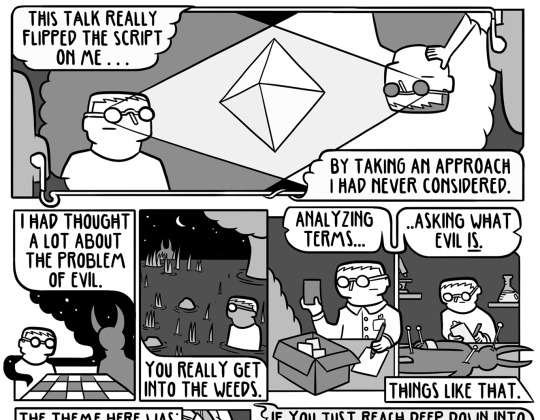
Or... why the Virgin Mary apparently mostly appears to kids:

The world of ‘weird spiritual and religious ideas’ is just something I'm really into, and that stuff dovetails in an interesting way with having a kid. Actually, my wife and I don't really fit into any "group". Some of the comics are about that:

It's not pushing any particular religious conclusion. It goes back and forth between, "here's this weird idea", and then:
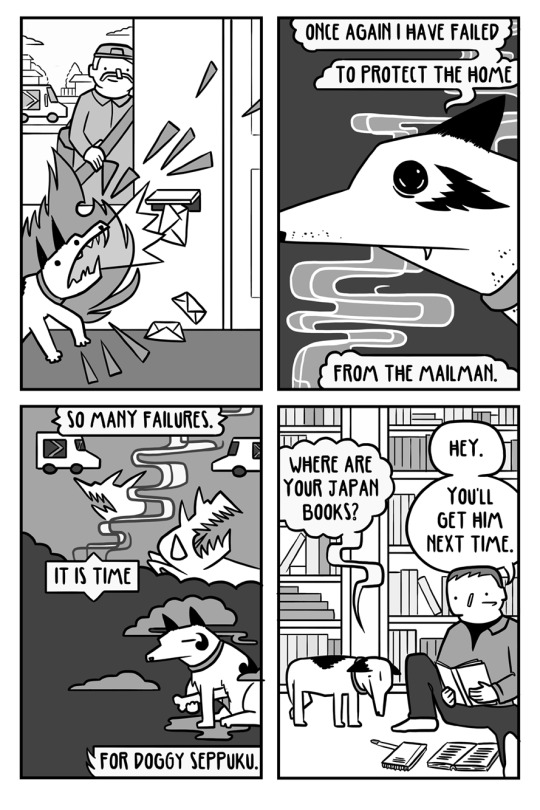
People seem to like it so far:
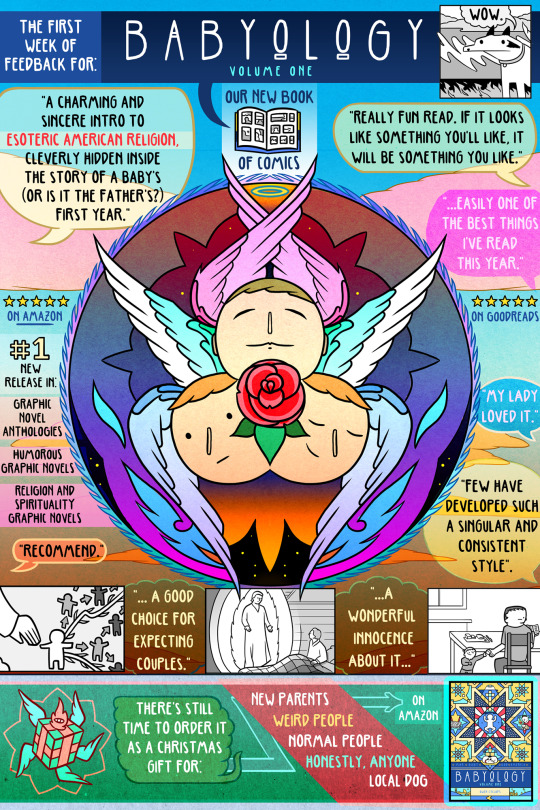
That's it really. If you have any friends who just had a kid, this would be a killer Christmas gift for them, but I'm running this ad because I think it makes a great gift for almost anyone. It's a real certified weird item from the internet that I put a ton of myself into. It's 360 pages, printed black and white newspaper style (so it's only $28) - comics all the way through. Weird enough for your freak friends, but normal enough for your mom. Thanks for reading this, here's the link if you're into it: http://amazon.com/dp/B0CPC9T741

199 notes
·
View notes
Text
♱ Dance with the Devil ♱
Against my will, I was inspired to write more for WHB. Istg some of these characters aren’t even my biases but their paraphilias are too creative. I hope you all enjoy reading this <3
Characters:: Sitri, Leviathan, Astaroth, Glasyalabolas, Paimon, Amon, Marbas, Gabriel, Minhyeok
Note:: Nsfw, pls take note of each character’s paraphilia before reading, noncon for Gabriel, MH-2 spoilers for Minhyeok, MINORS DNI

♡ If you like black tea, you are a perfect fit for Sitri. He often brews your favorite drink for the purpose of enjoying your satisfied smile, your bittersweet kisses, the melody of your palpitations as he makes love to you. If you ever send him a recording of your heartbeat, he will save it on his phone and listen to it religiously in your absence. Just don’t be shocked if he uses your gift for impure reasons; his imagination can only do so much.
♡ Leviathan enjoys the sensation of your hands around his neck, but what more if you were to experiment with his kink? Does he get more excited when you use your bare hands? Does he prefer the metal chill of rings or the soft lace of gloves against his skin? Would he come faster if you dig your fingernails into his throat—and if yes, what if your nails were longer, sharper? There are so many factors at play and you have all night to find out~
♡ Astaroth’s kink is perfect for literature lovers!! If you write erotica, he will gladly proofread your work, going so far as to enact the scenes and his suggested revisions. Another time, you asked him to read you a “bedtime story” and he complied after much pestering. He accepted your book and read it aloud in his soothing voice…then upon reaching a raunchy scene, he looked up from the page, met your cheeky gaze, and joined you in bed <3
♡ Once you were done kink-shaming Glasyalabolas, you decided to indulge him. His paraphilia is creepy, to say the least, but you knew what you were getting into. The best method? Play dead. You can’t resist the occasional moan or involuntary shudder, especially when he is touching you, but it certainly does wonders for his arousal. You’re his Ophelia, his Sleeping Beauty—beautiful, voiceless, and completely at his mercy.
♡ The only thing Paimon enjoys more than your blood is the sight of your body decorated with cute bandages!! Once he’s had enough of you, he will treat your wounds and present you with a set of printed Band-Aids. Here, would you like a pink one for your finger? What about a heart pattern for your thigh? A smiley face on your neck? Even better, what if your Band-Aids match the stickers on his horns? Take your pick~
♡ Sometimes, you wonder if Amon gives you tasks which he knows you will fuck up. There are telltale signs—his constant gaze, a hint of a smile, empty reassurances which somehow lead you to his bedroom. It begs the question: How would he react if you were to make a mistake in bed? Would he still smile after you “accidentally” touch a sensitive spot or ruin his orgasm? How will he react once he realizes you’re doing it on purpose?
♡ If Marbas were to cite an example for the term “heaven and hell,” it would be your moments of intimacy. He encourages you to restrain him to the best of your ability—tying complicated knots, using strong materials, testing his new set of regular restraints—then use his body as you’d like. It’s difficult to say who enjoys it more, especially when you are relishing the sight of him beneath you, totally submissive and desperate for your touch.
♡ Considering your history, your sadism towards Gabriel is warranted. So once he is defeated, in a church no less, you waste no time in humiliating him. If he refuses to yield, it only takes a few minutes to bend him over the altar and force him to face the image of his God. How does it feel to be watched by the passive, artificial faces of his creator and fellow angels? At any rate, the stained glass casts such pretty shadows on his defiled body~
♡ Of course Minhyeok knows your underwear preferences. The color, the style, the type of fabric, every detail. So when he finds a black lingerie set in your closet, he recognizes it as a new purchase—but for who? The next thing he knows, he is visualizing the lingerie on you and calling you for answers. Whether or not he understands your invitation, that specific underwear will frequently disappear from your room.
♡
Sitri fic ๑ Lucifer fluff ๑ More headcanons
Fun fact, a day after I wrote Glasyalabolas and Sitri’s headcanons, they came home in my gacha pull. D-Did I summon them?? (´⊙ω⊙`)
So far, my favorite devils are Leviathan, Sitri, Astaroth, and Satan but the other characters’ paraphilias are…….interesting to write about, to say the least. Cheers to more hornii xD
Tag a WHB enjoyer!! @sparkbeast20 @2af-afterdark @d34dlysinner @pinkaditty @og-in-a-bog @h2o2-and-baking-soda @paradivis @potol0ver @obeythisass @gr0tesquerom4ntica @dobaekki @binar-es @ushitoshiii @yanmaresu @beelsjuicytitties
#whb#what in hell is bad#whb x reader#what in “hell” is bad?#whb sitri#sitri#sitri x reader#whb leviathan#leviathan#leviathan x reader#astaroth#astaroth x reader#glasyalabolas#glasyalabolas x reader#whb paimon#paimon#paimon x reader#amon#whb amon#amon x reader#marbas#whb marbas#marbas x reader#gabriel#gabriel x reader#minhyeok#mdni#g/n reader#spicy warning#jessamine-writing
387 notes
·
View notes
Text
UPDATE 6/16/2024: TABLET IS FUNDED!! Digital commissions will reopen as normal. This page is to remain up as an archive and for possible future reuse.


These will work similarly to my digital commissions, only with a far quicker turnaround time and less emphasis on super fine polishing, hence the seriously slashed prices. LIMIT 3 CHARACTERS for halfbody; LIMIT 2 CHARACTERS for fullbody!
For purchases, questions, examples, and absolutely anything else you may be wondering about:
ADD ME ON DISCORD @ shebbz (preferred method!)
EMAIL ME at [email protected]
or message me here on Tumblr!
To futher entice you, I'm offering COUPONS! Redeem at checkout to get a discount on any purchase of a halfbody or fullbody:
$2 OFF if i've drawn this character before
$5 OFF for a drawing of a ship i ship
Coupons DO NOT stack; limit one per purchase!
CURRENT SLOTS:
closed for now!
SEE BELOW for what I will/won't draw (same rules as my digital commissions), as well as terms, conditions, and more:

Buyers will receive their artwork privately at full resolution in .PNG format. All commissions are signed and dated.
All commissions will also be posted here on my Tumblr, at a smaller resolution with a prominent additional watermark, after the buyer has received and approved the final piece. The buyer may be tagged in the post, or may choose to remain an anonymous.
Payments will be through PayPal. I will give you my PayPal once I agree to your commission. All payments are due up front in full.
Payment
After being completed, the commissioned artwork will be sent to you, the buyer, in .PNG format through email to ensure a near-lossless file. Alternate delivery methods are available upon request.
You must pay the entire price in advance, but only if we decide to go through with the commission.
Termination
You may cancel the commission at any time and receive a full refund of your payment until the commission is completed and sent. If I have already sent you the completed .PNG file of the commission, you are no longer able to request a refund for any reason.
I may cancel the commission at any time and fully refund your payment if I feel I am being coerced into drawing something I am uncomfortable with, but I will not cancel a commission without giving several clear warnings first.
Rights
You may use the commission for any personal or educational purposes, including most social media profiles. You may repost the commission to social media or other websites as long as I am credited by clearly linking my Tumblr. You may use the commission for an icon, header, background, etc. on your personal (i.e. not business) social media profile as long as I am credited.
You may not use the commission for business purposes or profit off of it in any way, such as using it on icons/banners/promotional materials on a for-profit social media account (ex. Twitch, Etsy, official business Twitter accounts), uploading it to merchandise printing sites (ex. Redbubble, Cafe Press, TeePublic), tracing/spoofing the design in your own creative works, incorporating it into a larger creative project (ex. a book, game, or comic), etc. You may not license the personal/educational usage rights to third parties. You may not edit or repurpose the commission in any way that supports hate groups, promotes hateful or bigoted ideology, incorporates iconography and/or dogwhistles of hate movements, etc., whether implicitly or explicitly.
I reserve full legal ownership of the commission and I may repost it to any site. I may use, edit, and reproduce the commission for any and all purposes. In the event of a cancelled commission, you forfeit all usage rights for the incomplete assets and may not edit or repurpose them in any way.
By commissioning me you agree to these terms and conditions.
#this has unfortunately been a long time coming; my tablet's been acting unpredictably for over a year now in a few different ways#shebbz shoutz#commissions#commission info
71 notes
·
View notes
Text
Things I Adore About Diamond Dog Trent (in Chronological Order):
Intense confusion over Beard barking that becomes Roy scaring the shit out of him (again) as he slams the door
"Oh, I'm in." IMMEDIATE. NO HESITATION. 100% COMMITMENT. Keep in mind that he's just been told they share their "most initiate thoughts, feelings and experiences" like oh, I don't know... the fact that you're gay? But Trent is Ted's The Lasso Way's #1 Fanboy so he's feeling safe and validated, baby!!
This is very much enhanced by the return of the rainbow mug
30 seconds into his new membership and Trent has gotten used to the barking enough that he can manage an awkward little wave of acknowledgement. 10/10 very cute
Subtle eye-narrowing of judgment at Ted right after Beard's "Unbelievable." They really are on the same wavelength this episode I'm digging it
"Can I just talk whenever?" OH I'M SORRY, IS TRENT "BRINGING THE HEAT" CRIMM POLITELY REQUESTING PERMISSION TO ASK POINTED, PERSONAL QUESTIONS? We love us some character development, yes we do
Teeny tiny smile when Higgins agrees with him. He's! So! Proud! Of! Himself! And he should be!!
Copying Beard's pointing. It reminds me of him subtly flipping Jamie off but also kinda pretending like it's a coincidence. Trent wants to be included so, so badly and he's someone who displays that by mimicking the actions of those around him. Something, something, Isaac's study of body language
The fact that for once Trent isn't holding his notebook and doesn't stop to grab it. He has a good handle now on what can and cannot go into his book. "Don't print that" is a running gag he no longer needs
A more meta-y take, but I love that Trent's first meeting is the perfect example of what the Diamond Dogs are meant to be accomplishing. It's not just a place to vent or get platitudes (though it's that too), but rather to receive the honest, sometimes hard-hitting advice so you can make better and more informed decisions. Ted went in looking for sympathy and got a doozy of a wake-up call instead, which I think highlights the group's purpose for Trent far better than many other meetings might have
You can see Trent open his mouth a little bit while the others are howling like he wants to join in (because he does HE DOES) but doesn't quite have the courage yet. It's only when the others quiet down - when he's not 'imposing' on 'their' thing - that he lets out that little *woof!* of his own
The woof. Yes, that gets its own bullet point
721 notes
·
View notes
Text
How to Improve Your Handwriting in Japanese
Learning to write in Japanese, teaching others to learn to write in Japanese, and watching Japanese people write in Japanese has taught me that it’s hard to write in Japanese. Remembering how to write the kanji in the first place is hard (especially with the ease of writing in Japanese on the computer or phone), remembering the stroke order and then figuring out how to fit the character into the space that you have - these are all difficult. And then on top of that, you don’t want these beautiful characters to look like you were bouncing up and down on a dirt road while you wrote them.
Handwriting in any language varies by person. There are people whose handwriting is sloppy in Japanese, just as in any other language. My handwriting in English isn’t perfect either, but I want my kanji to look less like shaky squiggles and more like, well, a native Japanese speaker’s characters. So I decided to break down how I go about improving my Japanese handwriting.

Practice
When you learn to write in English, you practice your letters over and over again. When you first learn kana and then kanji, it is also a good idea to write them over and over again. This helps many people to remember the characters (stroke order, spatial placement of each part of the character), and by writing the characters over and over again you will be able to write more quickly. You also won’t have to look up simple characters over and over again when you want to write a composition or a letter.
When I first started writing compositions by hand in kanji I remember looking up a character in the dictionary to check stroke order or to check how the kanji was written more often than not. This is a difficult way to write anything and takes a lot of time. Practice will help you to remember the characters and not have to stop to check your dictionary as often.
A high school friend told me that her mother would sit her down at the table every night and force her to work on her penmanship until it was what her mother deemed suitable. When we wrote our AP English essays in class, her penmanship was impeccable, although it took her much longer to write the essays than most of the other students. The result of what she considered torturous practice was amazing handwriting that made me jealous. If I had spent every night laboriously perfecting my penmanship I might also have attained that kind of handwriting - but I did not.
This is an extreme example, and I’m not saying you have to have perfect handwriting, but if improving your handwriting is something you would like to accomplish, taking the time to practice will certainly help your penmanship.
Books
There are Japanese books dedicated to this, because beautiful handwriting is desirable in all languages, but they are written in Japanese and I personally didn’t want to buy a book for this purpose.
Websites
Websites are a bit more difficult to come by because most people want to make some money off telling you their penmanship secrets. However, there are a few websites with some examples of good penmanship.
Links
Here are some online links for handwriting practice:
Chibi Musu Drill is where I look for kana practice for my toddler. They have a variety of drill print-outs that you can use to practice writing the characters correctly. This is especially helpful if you are self-studying as it helps with the shape of characters and the stroke order, and how the stroke should be finished (i.e. abrupt stop or drag and fade out to a tail). There are also tests you can print out for kanji. The site is all in Japanese.
Hiragana | Katakana | Kanji
Seiho’s YouTube Calligraphy School - VIDEO - Only in Japanese but the videos are easy to follow since she uses a red pen to highlight where to pay attention. This is more in-depth but has helpful hints on improving your kanji balance, but you can search 字がきれいに書く方法 to get more results.
Yumefude Penji on Instagram has videos showing how to write kanji properly.
How I Practice Handwriting in Japanese
For Kana
To practice handwriting kana, I find an example of good penmanship from a website. It’s best if the example is larger, or if I can blow it up. Then I print it out with darkened font. Drill print-outs also work well as they have characters for you to trace, then space for you to practice on your own.
I put a sheet of clean paper on top of the print-out and make sure I can read the characters through the clean paper. You can also get tracing paper. Then, I trace the characters multiple times. I try to feel the flow of the character as I trace it and to note if the stroke ends abruptly (とめ), has a kink in it (はね), or if it fades out to a tail (はらい).
Lastly, I practice on my own. I use the feel of the character I traced and try to replicate it. I compare my own work to the original sample, and try to determine how to get the characters to look closer to the original sample. My character might be too skinny, too round, or have a stroke out of place. I usually only do one character at a time until I am satisfied, and then move on to the next.
For Kanji
When practicing kanji, first, I use blank paper, download genkouyoushi (Japanese composition paper), or a notebook with wider line spacing for writing practice than I would for simply writing down vocabulary or notes. You can also buy special kanji practice notebooks. I do this so that I have the space to cleanly write out kanji with more strokes, rather than having to bunch together the strokes so that I can hardly read it. This way, I can practice the strokes with more room and pay attention to how the kanji fits together.
Then, I write the character several times. I try to get a muscle memory going for the character, remembering the individual parts, the radicals, the stroke order and what the kanji means. This helps me to remember the kanji, and then to understand how the individual parts fit together.
I am careful to not copy the typewritten Japanese characters, for these are often different than the handwritten characters. Using a kanji textbook or a website where they teach handwritten kanji is the best way to learn to handwrite kanji. Some dictionary apps also show stroke order and will show the handwritten version so you can see the difference.
9 Tips for Better Handwriting
Source
1. Hold your pen properly / ぺんを正しく持つ
2. Sit with proper posture / 正しい姿勢で座る
3. Create a calm setting where you can concentrate / 落ち着いて集中できる空間を作る
4. Write using the correct stroke order / 正しい書き順で書く
a. From the top to the bottom / 上から下へ
b. From the left to the right / 左から右へ
5. Take care with the Stop - Wing - Sweeping Stroke / とめ・はね・はらいを丁寧に

Showing stop - wing - sweeping stroke in kanji
6. Modulate the size of the character and write slowly and carefully / 大きさにメリハリをつけながら、ゆっくり書く
7. Make sure the characters rise to the right / 右上がりになるようにする
8. Make sure the spacing between lines is equal / 線と線の間隔が等しくなるようにする
9. Write with the intention of being read by others / 人に読まれるつもりで書く

My handwriting in Japanese is far from perfect, but when I have a chance I like to hand write characters to get a better feel for them and for their meanings. I hope this guide helps you to improve your penmanship!
#writing in japanese#japanese handwriting#improve your handwriting in japanese#japanese#japanese language#japanese langblr#japanese studyblr#字をきれいに書く方法#tokidokitokyo#tdtstudy
136 notes
·
View notes
Text
Rewind the Tape —Episode 1
Art of the episode
During our rewatch, we took note of the art shown and mentioned in the pilot, and we wanted to share. Did we miss any? Do you have any thoughts about how these references could be interpreted? How do you think Armand and Louis go about picking the art for their penthouse in Dubai?

The Fall of the Rebel Angels
Peter Bruegel the Elder, 1562
This painting is featured in the Interview with the Vampire book, and it was important enough to be included in the draft pilot script!

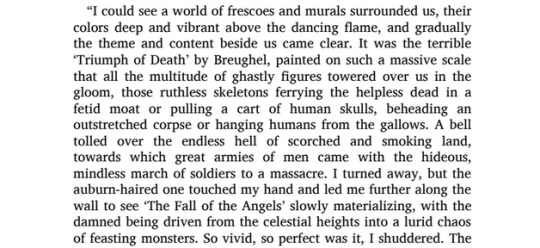
Bruegel the Elder was among the most significant Dutch and Flemish Renaissance artists. He was a painter and print-maker, known for his landscapes and peasant scenes.

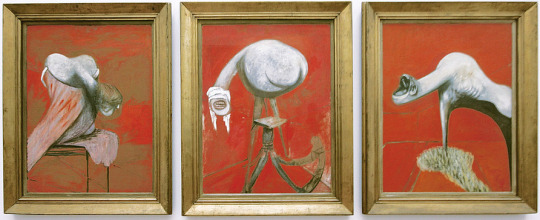
Three Studies for Figures at the Base of a Crucifixion
Francis Bacon, 1944
Bacon was an Irish figurative painter, known for his raw, unsettling imagery and a number of triptychs and diptychs among his work. At a time when being gay was a criminal offense, Bacon was open about his sexuality, and was cast out by his family at 16 for this reason. He destroyed many of his early works, but about 590 still survive. The Tate, where these paintings are displayed, says this about the work: "Francis Bacon titled this work after the figures often featured in Christian paintings witnessing the death of Jesus. But he said the creatures represented the avenging Furies from Greek mythology. The Furies punish those who go against the natural order. In Aeschylus’s tragedy The Eumenides, for example, they pursue a man who has murdered his mother. Bacon first exhibited this painting in April 1945, towards the end of the Second World War. For some, it reflects the horror of the war and the Holocaust in a world lacking guiding principles."
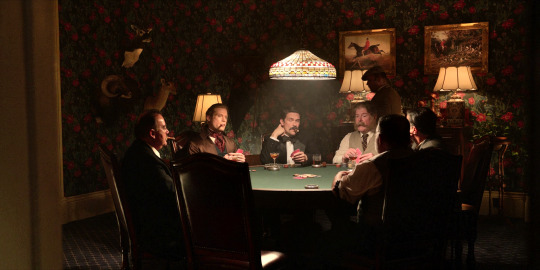
On the Hunt or Captain Percy Williams On A Favorite Irish Hunter and Calling the Hounds Out of Cover
Samuel Sidney, 1881 [Identified by @vfevermillion.] and Heywood Hardy, 1906 [Identified by @destinationdartboard.]
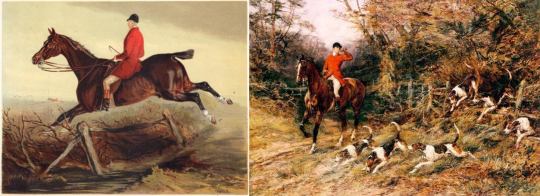
Sidney was an English writer, and his prints usually accompanied his publications about hunting, agriculture, and about settling Australia during the colonial period. Hardy, also British, was a painter, in particular an animal painter. There's also a taxidermy deer, ram, and piebald deer on the wall.
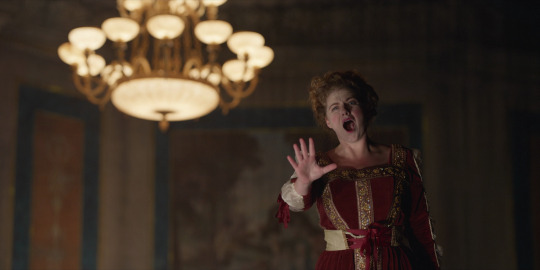
Iolanta
Pyotr Tchaikovsky, 1892
The opera Louis and Lestat go to was composed by Tchaikovsky, another gay artist. The play tells a story "in which love prevails, light shines for all, lies are no longer necessary and no one must fear punishment," as put by Susanne Stähr for the Berliner Philharmoniker.

Strawberries and Cream
Raphaelle Peale, 1816 [Identified by @diasdelfuego.]
Peale is considered to have been the first professional American painter of still-life.

Outfits inspired by J.C. Leyendecker
Leyendecker was one of the most prominent and commercially successful freelance artists in the U.S. He studied in France, and was a pioneer of the Art Deco illustration. Leyendecker's model, Charles Beach, was also his lover of five decades. You can read costume designer Carol Cutshall's thoughts on these outfits on her Instagram.

The Artist's Sister, Melanie
Egon Schiele, 1908 [Identified by @dwreader.]
Schiele was an Austrian expressionist painter and protege of Gustav Klimt. Many of his portraits (self portraits and of others) were described as grotesque and disturbing.
A Stag at Sharkey's
George Wesley Bellows, 1909 [Identified by @vfevermillion.]
Bellows was an American realist painter, known for his bold depictions of urban life in New York City.

Mildred-O Hat
Robert Henri, undated (likely 1890s) [Identified by @nicodelenfent, here.]
Henri was an American painter who studied in Paris, where he learned from the Impressionists and determined to lead an even more dramatic revolt against American academic art.
Starry night
Edvard Munch, 1893 [Identified by @vfevermillion.]
Munch was a Norwegian painter, one of the best known figures of late 19th-century Symbolism and a great influence in German Expressionism in the early 20th century. His work dealt with psychological themes, and he personally struggled with mental illness.
If you spot or put a name to any other references, let us know if you'd like us to add them with credit to the post!
Starting tonight, we will be rewatching and discussing Episode 2, ...After the Phantoms of Your Former Self. We hope to see you there!
And, if you're just getting caught up, learn all about our group rewatch here ►
#louis de pointe du lac#daniel molloy#lestat de lioncourt#vampterview#interview with the vampire#iwtv#amc interview with the vampire#interview with the vampire amc#amc iwtv#iwtv amc#IWTVfanevents#rewind the tape#in throes of increasing wonder#analysis and meta#art of the episode
97 notes
·
View notes
Text
Berenice Abbott in Philip Johnson’s apartment

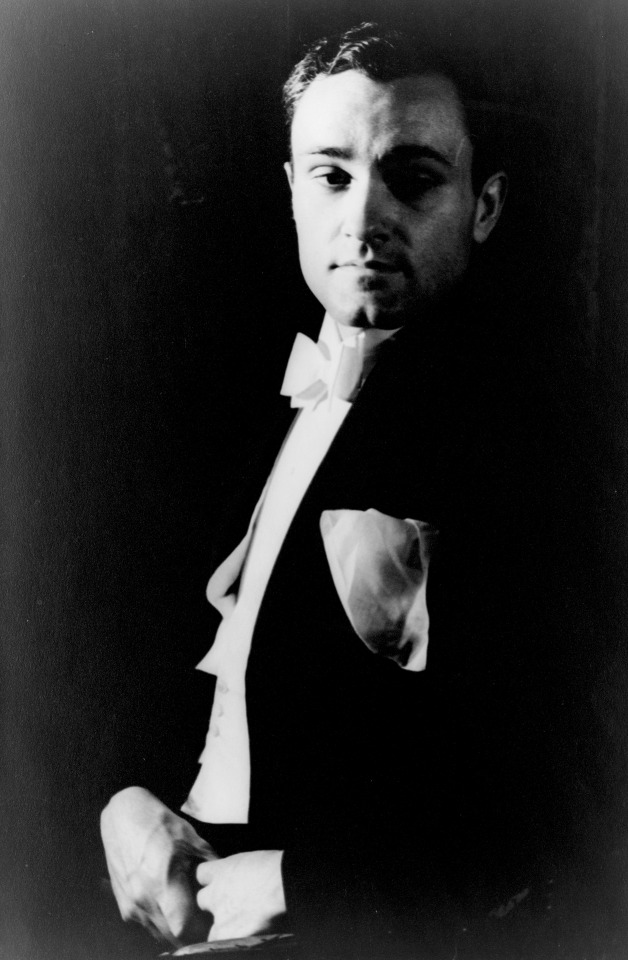
Berenice Abbott, 1930 (Walker Evans) / Philip Johnson, 1933 (Carl Van Vechten)
These portraits are the most obvious choices from this time period and conveniently suggest the biographical contrast between the two: Abbott had been a struggling American artist in Paris, an assistant to Man Ray, but she later established a portrait business, built a reputation and gained a steady flow of sitters. In January 1929, at age 30, she left for New York.
Abbott departed on the ship from France with the archive of Eugène Atget: 17 crates according to the Julia van Haaften's biography. She naively thought selling Atget prints and licensing would provide a healthy income.
The new architecture of the city enthralled her and Abbott quickly began to conceive and photograph a topographic survey of the city. By fall 1929 the stock market had crashed, the Great Depression had begun and the portrait business was no longer promising. Abbott wanted to charge $150 a portrait, at a time when you could get one done for a dollar. This environment forced her to change business models, looking for patrons for the New York project.
Abbott first encountered Philip Johnson in New York in 1931, at the “Rejected Architects” exhibit, a salon des refusés for modern architects and an early introduction of the International Style to New York.
Johnson was a 25-year-old who came from inherited wealth. Rachel Maddow’s "Prequel: An American Fight Against Fascism" suggests his portfolio produced, in today’s dollars, from $240,000 to $1.2M in dividends a year. His financial backing of the architecture department at MOMA resulted in him becoming director of that department. He had discovered Mies van der Rohe on one of his traipses across the continent and was eager to bring the new style to New York. While Johnson was financially very comfortable, he had unsatisfied ambitions, larger than being a curator of architecture and beyond architecture itself.
In 1932 Abbott was part of MOMA’s Murals by American Painters and Photographers exhibit, which Johnson certainly would have been aware of, if not directly involved in, as the point of the show was large modern murals for architecture projects such as Rockefeller Center in the form of seven by twelve foot murals. Greg Allen has the backstory on that exhibit (since his 2010 post the full catalog with her photos has been published on the MOMA site).
For her New York survey, Abbott was looking for $18,750 ($390,000 in today’s dollars), enough to fund a year long project, travel, a car with two full time assistants to deliver 350-500 prints and negatives. Johnson did not financially support Abbott’s New York project, nor did the museum sponsor it, but he offered a strong letter of recommendation, on MOMA letterhead: "You have a deep love for New York, you are an excellent photographic technician and you have the artistic power of selecting the essential."
The goal was to find 75 patrons among the wealthy MOMA donors to contribute $250 each. Despite Johnson’s endorsement, this fundraising effort was a flop. It would take her until 1940 to finish it, but "Changing New York" became one of the great photographic projects of the 20th century.
Van Haaften describes an architecture and photography exhibition Johnson and Abbott planned to do together, called "America Deserta," about the visual repercussions of the Depression. It sounds like an early version of what we now call "ruin porn." She writes that Johnson could have financed the project out of his own pocket, but neither he, nor the museum, pulled the trigger. (Decades later, architecture critic Reyner Banham wrote an excellent book about the actual desert titled "Scenes in America Deserta")

Johnson was doing interior design in New York for friends and acquaintances, hoping the examples of his work could help establish him (and the International Style he had signed on with). An early project was for MOMA’s Alfred Barr. Mark Lamster writes in "Man in the Glass House" that Barr couldn’t afford the real Mies furniture that Johnson had already acquired for himself, so Johnson designed knock-off tubular chairs.

cover of Arts and Decoration, September 1933, from the Burlingame, California library via archive.org
Johnson’s own apartment was his first top-to-bottom interior design project. He was eager, bordering on desperate to get paying clients, to establish himself. He didn't need the money, but wanted clients as a stamp of approval from the New York elite, like the Rockefellers. He enlisted Abbott to take photos to premiere it in Arts and Decoration magazine.

The International Style had already taken root in Los Angeles, but New York was not ready for what he was offering. Perhaps Abbott’s photos of his apartment are part of why the new thing seemed unconvincing. Starting with the watercolor cover or paging through this magazine aimed at the wealthy, the features contrast traditional style versus examples of the new style.
If you've never been in a modern interior before and these photos are your first glimpse, it's not appealing. Johnson was no Neutra and he had not found his Julius Shulman. The magazine's reproduction quality of the photography is not good. Abbott's photographs feel cramped. The lighting is a combination of murky corners and distracting shadows. The styling, a fiddle leaf fig, the place settings at the dining table, feels forced.

In terms of art history, the most interesting of Abbott's photographs features a painting directly from the Bauhaus. It's Oskar Schlemmer's Bauhaus Stairway (1932). Lamster outlines the very messy deal that brought the painting to New York. In March 1933 Barr asks Johnson to buy it, unseen, thinking it will end up at MOMA. As the Nazis breathe down Schlemmer's neck for being a "degenerate artist," Johnson sends a telegram offering a price, but then claims a typo added a zero and pays 10x less. This dispute isn't resolved until after the year 2000. Johnson keeps the painting in his collection for another ten years.

the captions drop the "e" Abbott had added to her name (Bernice vs Berenice).
What explains the vast difference between the great photos Abbott is making on the streets of New York and these mediocre interiors? She creates "Exchange Place" the same year. Spending time with Abbott’s archive on NYPL and Getty looking for interior photos to compare to these photos of Johnson's apartment to, left me with another question: Why are photographs of interiors uncommon until the 1940s? In her Paris portraits the interior of her studio plays a significant role as background.
Van Haaften writes that Abbott is using two cameras in these early years in New York:
5x7 inch view camera (with reducing back to 12x9cm, which is a large “medium format” negative )
Graflex that she acquired to do portraits of Guggenheim children (probably a 4x5 inch press style camera).

Abbott is on a ladder to make the photographs of Johnson's place and perhaps the combination of lens focal length and the size of the apartment presented a challenge in creating enough space. It’s possible, despite the two cameras, that she simply didn’t have a wide enough lens to do interior work at a time when lenses were expensive and money was tight. Or that she didn’t prefer to use spotlights or flash. Perhaps her focus was so intense on the exterior of the city that she rarely set up the camera indoors.
For Johnson, it’s possible to imagine if New York had been more open to the new style, if the magazine caused a stir, if he was encouraged to become an architect at this moment, his descent into fascism would have never happened. After the photos are published in the September 1933 issue, 1934 is a rollercoaster year for Johnson: he has a breakout hit of an exhibit in Machine Art (March-April). But by December, he quits MOMA to focus on his fascist party. He’s 28 years old. His pursuit of the fantasy of a domestic version of Nazism brings him to Germany, to cheer on the invasion of Poland. Lamster writes that he only to returns to architecture in 1941, when it’s clear that he has barely escaped being charged with treason. He goes from being a millionaire who shipped his own car to Europe for his Nazi tour to cleaning Army toilets.
Van Haaften’s biography of Berenice Abbott is not specific about when Abbott broke off her friendship with Johnson. We can assume it happens sometime between the apartment photoshoot and Johnson leaving MOMA. Abbott was a communist or socialist for most of her life and American Nazis like Johnson were very clear on what they would do to communists if they gained power. Van Haaften writes: "the two friends later parted ways over Johnson’s political views and his enthusiasm for the Third Reich." The book's footnote indicates the source for this is her 1993 phone interview with … Philip Johnson.
21 notes
·
View notes
Text
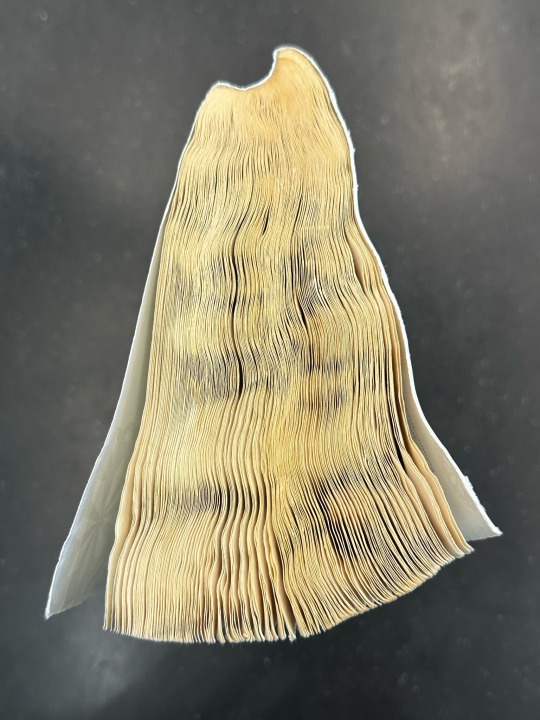

What Do Library Staff Do All Day?
Sometimes we weed books and other items!
We weed our collections using different criteria including shelf space, circulation stats, and condition. Here are examples of two items that we weeded for poor condition yesterday — the book for (a LOT of) water damage and the DVD for being so scratched up that it would no longer play correctly.
While we're on the subject, please please PLEASE remember to take good care of items that you check out from the library. When items are damaged, we need to weed them from our collections. Unfortunately, we can't always afford to replace them until we have enough money in our budget ... and if the damaged items are out of print, then we can't replace them at all!
📚☹️💽
67 notes
·
View notes
Text
zine finance and fulfillment... TWO!
this is a follow up post to my original “zine finance and fulfillment” post that i made oh gosh a year and a half and a few big zine projects ago. i come to you now with some more thoughts on my process. so here are some things that you can consider before embarking on your beautiful journey**
WHAT MY LAST POST COVERED: what goes into my pricing, which websites i use for fulfillment, the epic highs and lows of flat rate shipping.
WHAT THIS ONE COVERS: some warnings, estimates for perfect bound books, detailed numbers for diy zines, explanation of my fulfillment timeline
**note: this is aimed at the rotten people of the united states of america. some tips may be generally applicable, but my numbers are in USD and my estimates are tailored to US prices as of december 2024. anyway!
NUMBER ONE: YOU NEED TO HAVE EXTRA MONEY LYING AROUND
zines are beautifully diy. you can make them for free if you steal shit or use something you have lying around. however. the second you start selling them online, you need to have a little extra money as a cushion.
NUMBER TWO: YOU NEED TO BE OKAY LOSING THAT MONEY.
especially if you operate with as thin margins as i do OR you are doing a p4p model. you will lose money. something will happen to you. sorry. i can’t believe i priced my very first zine at $8 shipped worldwide for a pro printed booklet. what the hell. the hubris of youth.
NUMBER THREE: WHILE WE’RE TALKING MONEY, LET ME HELP YOU ESTIMATE COSTS
i love transparency and oversharing. you can hear the specifics of my financials. assuming that you are selling black and white perfect bound books between 100-200 pages that you are buying online, and you are working in quantities somewhere from 50-150 books…
i assume that to get those books to my house, it will cost roughly $6.50 plus or minus a dollar depending on the length of the book. i tend to budget 50 cents per book for shipping materials. stripe fees are stripe fees; i just let my spreadsheet take care of that.
shipping cost. the beast that consistently costs more than i budget for. well. if you’re normal, and charge people the actual cost of shipping.... within the US, it’ll cost maybe $2.50 to ship a lightweight zine (<100 pages) and closer to $4.50 if it’s heavier or you want tracking [you can use media mail]. shipping to canada is consistently around $4 for lightweight zines, and $6-7 for perfect bound books using lettermail [possibly illegal]. everywhere else in the world is around $7 for lightweight zines and around $15 for heavier zines. whew. estimate your specific costs using the usps links i linked in the last post, but TO GET A BALLPARK you can use my numbers.
so anyway you will never see me pricing a perfect bound book less than $10 anymore, because $15 shipped would be my "i am planning to make no profits and give out no contributor copies" price, where i'd be reasonably certain i would not lose money.
NUMBER THREE AND A HALF: DIDN'T YOU JUST SELL A $5 ZINE. WHAT IF I DIY
okay, imagine for a second you’re not a clout-chasing sellout like me who makes perfect bound books. let’s say your zine is handmade. how does that shake out. great question. i will show you a picture of the exact breakdown of yaoi zine 5 costs.
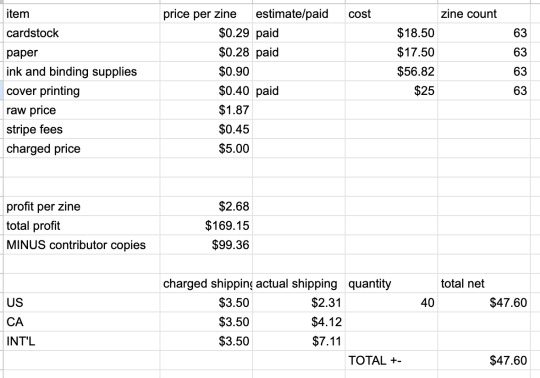
i’m not done yet, so i’m not sure how much money i’m going to lose on shipping. but i have no doubt that it will cut into the profits. but anyway, yeah. spreadsheets are your friend :)
NUMBER FOUR: SO HOW LONG WILL THIS TAKE ANYWAY?
alright. great question. i do a preorder model for all my zines. this is so i don’t have to worry about inventory or buying too many or whateva. this does mean, however, that my dear dear zine buyers have to wait longer. how long does my average zine fulfillment take, from posting the store link, to shipping the final zine?
i will use yaoi zine 4 as my example. it was a pro printed zine that sold around 100 copies, which is what i usually estimate i will sell in a two week preorder period.
i posted the store link august 27th.
i closed the store september 10th.
i ordered the zines september 11th.
the zines shipped september 17th.
they arrived at my house september 20th.
my first shipment went out september 24th [packing orders was more complicated because i was doing a large giveaway, and also selling shirts]
my final shipment went out september 27th.
so exactly one month! it took anywhere from a couple days (localish buyers) to a couple weeks (people who live outside the us) to get their zine.
NUMBER FIVE: HEY, YOU SKIPPED OVER THE MOST IMPORTANT PART OF THE TIMELINE.
yeah those four days of packing and shipping zines were um. grueling. luckily i was extremely underemployed at the time. unluckily i don’t have that much willpower so i only worked on shipping for a few hours at most each day.
here’s what you need to consider budgeting time for:
making zines (optional). i hand sew mine because i have poor judgment. for my 72 page zine, from first hitting print to tying off the thread, it takes around um. 10 minutes. damn i’m slow. you may be faster. this is the most time consuming part of the process, which is why i often skip it [also because 100+ pages is too thick to saddle stitch]
packing zines. most people will buy one zine and one zine only and make your life easy. pack all of these first, then do your “odd” orders separately. this part is pretty self explanatory. just stuff an envelope. you can do this in a hour or two.
addressing zines. i handwrote all the yaoi zine 5 addresses, in another lapse of judgment. you can print them on labels to make it easier. or, if you’re shipping media mail, you can buy addressed postage through pirateship. this is the most variable time sink.
buying postage. be prepared to spend an hour at the post office at a time using the pitney bowes machine. do not bother the stalwart workers of the usps with your dozens of packages lmfao. especially because half the time they’ll tell you that they don’t think letter mail will work out for you (it always has for me). also don’t try to ship them all in one day i get soooo sweaty and tired shipping like 20-30 at a time.
well. that’s everything i can think of. hopefully i said something non obvious. or at the very least satisfied your curiosity as to how much money i make.
EDIT THIRTY SECONDS AFTER I POSTED THIS: my dear oomf julian asked how i pick a printing company.
well normally i choose based on price. bookmobile has consistently had the best prices for the small runs i do of simple books.
i use mixam if the run is veryyyy small or i'm just making a one off.
if price is no object and i want to pick the best paper irl etc etc, i go to my local guy.
9 notes
·
View notes
Text
To a large extent, there is still much confusion regarding the creation of MONEY. Some people still think the government actually creates money as if it were in ancient times. When I say MONEY is no longer TANGIBLE, but it is VIRTUAL, many seem to fail to grasp just how much the world has changed. In ancient times, the state minted the coins AFTER 600 BC attempting to certify the weight to facilitate commerce. However, the government quickly learned that there was profit to be made, which is known as the “seigniorage,” referring to the difference between the intrinsic value of the metal and the declared value. In such a world, the state predominantly created money supply, discounting leverage from banking and counterfeiting.
Today that is about as far removed from how the economy functions as the next inhabitable planet. In the example I used that if a foreign investor buys domestic real estate, he is increasing the domestic money supply. The conversion of his local currency to the domestic currency is NOT dictated by some FIXED quantity created by the central bank. It is just electronic. Nobody actually prints anything , and the central bank does NOT even create electronic currency. It is just a book entry. Because the foreign investor is bringing in cash and buys a TANGIBLE object (real estate), the net amount of cash in the domestic supply of money increases the same when the Fed bought US bonds under QE2. Banking also LEVERAGES the economy by creating MONEY. If you have $1,000 on deposit and I borrow $1,000, we both now have accounts reflecting $1,000 each. Again, the state did NOT create that money.
It is once more a book entry. This is how a BANK PANIC will take place. You go to the bank trying to get your $1,000, but the bank actually lent it to me. As long as you do not try to take out that $1,000, everything is fine and dandy. Therefore, MONEY is not TANGIBLE, and it is purely VIRTUAL! The idea that MONEY is supposed to be some TANGIBLE object actually ended in 600 BC once government got involved and began to manufacture a profit from creating money. As long as the economy is free, then you are free to keep your wealth in whatever object you desire, be it gold or real estate. MONEY is NOT a store of value, for it has always fluctuated, rising in purchasing power in recessions (NOW) and declining in booms.
8 notes
·
View notes
Text
The Marble Queen Review

The Marble Queen is a an amazingly drawn book, Gabrielle Kari is one of the greatest artists out there and her brilliant craftsmanship truly captures a unique voice in comics. I am impressed her illustrative style was captured on so many pages of the books really showing the level of heart that went into this work. The amazing use of paneling and page layout allowed for very dynamic use of the medium of comics breaking conventions from each other while feeling like bold artist moves on the page.
The book is hampered some what by being a YA book, it feels like at times there are areas that maybe would have been better served with more details but it does really edge what most YAs feel their able to do in a first novel. With lots of death, some blood and some implied sex. The pacing was a bit fast, there were moments that felt like they could have lingered longer and taken more time and perhaps the beginning starts a little slow but the romance does feel satisfying.
I think there are feelings I'd like to see explored more, the ending appears to set up a potential follow up book but it's ending is satisfying enough to simply imply potential conflict that is not needed. Anna does do a great job capturing Amelia's anxiety and the ways it manifests, the ways she tries to treat it, and how it affects her life. It is a great deception of that mental health struggle. I do wish we could have seen more into Salira's perspective, the white woman who doesn't know about being gay being the POV makes sense in the like cynical ways but I would have liked to get more into the interiority of Salira who does fall a bit into the "more butch brown woman who dots after he innocent white GF trope." I think that would have been felt a little less if we saw the world a bit more from her eyes. That said the book does do a solid job of showing plenty of fem brown women so I think it be an oversimplification to say it's just an example of that. It's worth noting only in that i know several other BIPOC women who might hesitate at it but I think we're in the clear here.

This book does feel like it in some ways compensates for being about gay women with good straight brothers who are very good boys. In general we get an idea that Salira'a kingdom is homonormative and see that in a page but from that point on basically everyone is implied to be straight in the kingdom. They leave some details vauge, some people could be bi, but this is all the reader chosing the details what we do see if M/F relationships, a set of women attracted to men, and one other woman who is confirmed to be gay but is also tied into a plot twist so I won't go into detail. That's not to day the queerness feels bad in the story it is good, it's the focus, it's great just that I felt there was maybe a little room for improvement within the bounds the story itself set's up. Unlike something like the lack of trans rep which it does not ever bother with so I wouldn't mention outside of like using it as an example for something I wouldn't take points off for. Regardless, my point is it would have been nice for like one more named character to have been queer.
I do really enjoy that both girls have some troubles in the new arranged relationship and both gave up something they love for it. I also enjoy that there is a twist for a lie that is told that while given a moment of weight is not turned into a giant drama moment and just given a tiny bit of time before the pair moved on. It felt more realistic for the two to understand why that lie was told.
Ultimately, this is a rather good story that I feel like was close to great but maybe fell behind just a little. That said I really liked it and I'd totally love prints of it and stuff. The main couple are cute and extra adorable towards the end. I like that there is a flare of action in the story and that the story had some big shifts in the status quo by the end of it. I love a lot of the sweet little moments. I love the ways it really pushed on anxiety as this thing in your life that can be consuming. It's a really great piece of art. If you enjoyed this review and want to see other reviews and support me making my own sapphic art you can support me on Patreon.
#The Marble Queen#Comics#GNs#Yuri#GL#Lesbian Novel#Lesbian GN#Lesbian Comics#Sapphic GN#Sapphic Comics#anxitey#review#Quick Review
14 notes
·
View notes
Note
This is maybe a complicated question but what sources (which for this purpose includes both novels and sourcebooks) would you recommend for learning about drow lore?
For Forgotten Realms drow lore specifically... I haven't read all of it by a long shot! Keep in mind that Menzoberranzan is one of many cities while you read these!! I haven't gathered all information about what different drow cities are Out There, but out of what I've read, I would recommend:
Sourcebooks:
Drow of the Underdark (SECOND EDITION DND, this is the TSR one. You want the one written by Ed Greenwood, NOT the third edition sourcebook of the same name). Some of it is editor mandated (such as prosthetics) but it's still a pretty good source. Should be available on archive.org or floating around on websites, I don't know if you can actually pick it up physically anymore.
Menzoberranzan Box Set (AD&D box set): Available on archive.org if you can't find it elsewhere. No account needed. Explicitly expands on Menzoberranzan-as-trade-hub, more details about the Houses, etc., all things that don't fit in novels.
Underdark (3rd edition supplement) - Play supplement for the Underdark. Expands more on non-Menzoberranzan locations and Underdark adventures and resources.
Out of the Abyss (5e adventure module) - covers a lot of the Underdark, including Menzoberranzan. You get a snapshot of Menzoberranzan in 5e as well as a bunch of other Underdark stuff.
Novels:*
War of the Spider Queen (Dissolution, Insurrection, Condemnation, Extinction, Annihilation, Resurrection): Six books, takes place during an event called the Silence of Lolth. Varied perspectives. Gives different views of various parts of drow society.
Liriel's trilogy (Daughter of the Drow, Tangled Webs, Windwalker): Three books by Elaine Cunningham. Very different protagonist from Drizzt, gives some context and greater fleshing out of the conditions priestesses go through in Menzoberranzan.
Side stories: Rite of Blood (prequel), The Direct Approach (takes place mid-trilogy), Answered Prayers (epilogue). You can find Rite of Blood in Best of the Realms vol 1. Direct Approach and Answered Prayers are in Best of the Realms vol 3, which can be found online in (cough cough) places, I don't think it's in print any longer. Drizzt's books: The character that quite literally started it all in Forgotten Realms, at least as far as drow publishing history goes. If you're buckling in for the marathon: Here is a slideshow of what to expect, with a text transcription.
Here is a reading order.
If you just want a crash course to get basic Menzo lore into your face:
Dark Elf trilogy (Homeland, Exile, Sojourn only if you're invested in Drizzt's story because that's his story of how he gets to the surface). Generations (Timeless, Boundless, Relentless). Generations revisits the Homeland timeline from the view of Jarlaxle and Zaknafein, both characters you'll be introduced to in the Dark Elf trilogy. *There is also Lady Penitent, that follows on from the end of WotSQ. I have read it, but it's not included in my overview because it explicitly addresses drow lore about their origins that as far as I can tell has been retconned as the editions advanced. However, if you are interested in reading it regardless, it is a trilogy with the books Sacrifice of the Widow, Storm of the Dead, and Ascendancy of the Last.
Peripherals:
(insert screaming about polyhedron and dragon magazine, i haven't even begun to go through all that yet, but if you want another example of a 'good drow' in the 2e era that isn't Drizzt, I recommend Polyhedron 97 which you can find here, which gives an example in Dusk, a drow tutor.)
ANYWAY UHH hope this helps a bit lmao. There's so much! And a lot of it is not consistent between editions either!
54 notes
·
View notes